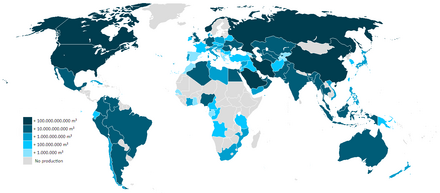Scientists at AWE were involved in testing for radioactive poison after the poisoning of Alexander Litvinenko. No gamma rays were detected; however, the BBC reported that a scientist at AWE, who had worked on Britain's early atomic bomb programme decades before, recognised a small spike at an energy of 803 kilo-electron volts (keV) as the gamma ray signal from polonium-210, a critical component of early nuclear bombs, which led to the correct diagnosis. Further tests using spectroscopy designed to detect alpha radiation confirmed the result.[11]
https://en.wikipedia.org/wiki/Atomic_Weapons_Establishment

The element iron can combine with chlorine at high temperatures in a strong exothermic reaction, creating a chlorine-iron fire.[117][118]Chlorine-iron fires are a risk in chemical process plants, where much of the pipework that carries chlorine gas is made of steel.[117][118]
https://en.wikipedia.org/wiki/Chlorine#Chlorine-iron_fire

This list of unusual deaths includes unique or extremely rare circumstances of death recorded throughout history, noted as being unusual by multiple sources.
https://en.wikipedia.org/wiki/List_of_unusual_deaths

Charondas (Greek: Χαρώνδας) was a celebrated lawgiver of Catania in Sicily. It is uncertain when he lived; some identify him as a pupil of Pythagoras (c. 580 – 504 BC), but all that can be said is that he lived earlier than Anaxilas of Rhegium (494 – 476 BC), as his laws were in use by the Rhegians until they were abolished by Anaxilas.[1] His laws, originally written in verse, were adopted by the other Chalcidic colonies in Sicily and Italy.
According to Aristotle, there was nothing special about these laws except that Charondas introduced actions for perjury, but he speaks highly of the precision with which they were devised.[2] The story that Charondas killed himself because he entered the public assembly wearing a sword, which was a violation of his own law, is also told of Diocles of Syracuse and Zaleucus.[3] The fragments of laws attributed to him by Stobaeus and Diodorus are of late (Neo-Pythagorean) origin.[4] Charondas is said to have commanded that if the nearest relative of an epikleros (something close to an heiress) did not wish to marry her, he was required to provide a dowry.[5]
https://en.wikipedia.org/wiki/Charondas

Radiochemistry is the chemistry of radioactive materials, where radioactive isotopes of elements are used to study the properties and chemical reactions of non-radioactive isotopes (often within radiochemistry the absence of radioactivity leads to a substance being described as being inactive as the isotopes are stable). Much of radiochemistry deals with the use of radioactivity to study ordinary chemical reactions. This is very different from radiation chemistry where the radiation levels are kept too low to influence the chemistry.
Radiochemistry includes the study of both natural and man-made radioisotopes.
Main decay modes[edit]
All radioisotopes are unstable isotopes of elements—undergo nuclear decay and emit some form of radiation. The radiation emitted can be of several types including alpha, beta, gamma radiation, proton and neutron emission along with neutrino and antiparticle emission decay pathways.
1. α (alpha) radiation—the emission of an alpha particle (which contains 2 protons and 2 neutrons) from an atomic nucleus. When this occurs, the atom's atomic mass will decrease by 4 units and atomic number will decrease by 2.
2. β (beta) radiation—the transmutation of a neutron into an electron and a proton. After this happens, the electron is emitted from the nucleus into the electron cloud.
3. γ (gamma) radiation—the emission of electromagnetic energy (such as gamma rays) from the nucleus of an atom. This usually occurs during alpha or beta radioactive decay.
These three types of radiation can be distinguished by their difference in penetrating power.
Alpha can be stopped quite easily by a few centimetres in air or a piece of paper and is equivalent to a helium nucleus. Beta can be cut off by an aluminium sheet just a few millimetres thick and are electrons. Gamma is the most penetrating of the three and is a massless chargeless high energy photon. Gamma radiation requires an appreciable amount of heavy metal radiation shielding (usually lead or barium-based) to reduce its intensity.
Activation analysis[edit]
By neutron irradiation of objects it is possible to induce radioactivity; this activation of stable isotopes to create radioisotopes is the basis of neutron activation analysis. One of the most interesting objects which has been studied in this way is the hair of Napoleon's head, which have been examined for their arsenic content.[1]
A series of different experimental methods exist, these have been designed to enable the measurement of a range of different elements in different matrices. To reduce the effect of the matrix it is common to use the chemical extraction of the wanted element and/or to allow the radioactivity due to the matrix elements to decay before the measurement of the radioactivity. Since the matrix effect can be corrected for by observing the decay spectrum, little or no sample preparation is required for some samples, making neutron activation analysis less susceptible to contamination.
The effects of a series of different cooling times can be seen if a hypothetical sample which contains sodium, uranium and cobalt in a 100:10:1 ratio was subjected to a very short pulse of thermal neutrons. The initial radioactivity would be dominated by the 24Na activity (half-life 15 h) but with increasing time the 239Np (half-life 2.4 d after formation from parent 239U with half-life 24 min) and finally the 60Co activity (5.3 yr) would predominate.
Biology applications[edit]
One biological application is the study of DNA using radioactive phosphorus-32. In these experiments stable phosphorus is replaced by the chemically identical radioactive P-32, and the resulting radioactivity is used in analysis of the molecules and their behaviour.
Another example is the work which was done on the methylation of elements such as sulfur, selenium, tellurium and polonium by living organisms. It has been shown that bacteria can convert these elements into volatile compounds,[2] it is thought that methylcobalamin (vitamin B12) alkylates these elements to create the dimethyls. It has been shown that a combination of Cobaloxime and inorganic polonium in sterile water forms a volatile polonium compound, while a control experiment which did not contain the cobalt compound did not form the volatile polonium compound.[3] For the sulfur work the isotope 35S was used, while for polonium 207Po was used. In some related work by the addition of 57Co to the bacterial culture, followed by isolation of the cobalamin from the bacteria (and the measurement of the radioactivity of the isolated cobalamin) it was shown that the bacteria convert available cobalt into methylcobalamin.
In medicine PET (Positron Emission Tomography) scans are commonly used in diagnostic purposes in. A radiative tracer is injected intravenously into the patient and then taken to the PET machine. The radioactive tracer releases radiation outward from the patient and the cameras in the machine interpret the radiation rays from the tracer. PET scan machines use solid state scintillation detection because of its high detection efficiency, NaI(Tl) crystals absorb the tracers radiation and produce photons that get converted into an electrical signal for the machine to analyze.[4]

Environmental[edit]
Radiochemistry also includes the study of the behaviour of radioisotopes in the environment; for instance, a forest or grass fire can make radioisotopes become mobile again.[5] In these experiments, fires were started in the exclusion zone around Chernobyl and the radioactivity in the air downwind was measured.
It is important to note that a vast number of processes are able to release radioactivity into the environment, for example the action of cosmic rays on the air is responsible for the formation of radioisotopes (such as 14C and 32P), the decay of 226Ra forms 222Rn which is a gas which can diffuse through rocks before entering buildings[6][7][8] and dissolve in water and thus enter drinking water[9] In addition, human activities such as bomb tests, accidents,[10] and normal releases from industry have resulted in the release of radioactivity.
Chemical form of the actinides[edit]
The environmental chemistry of some radioactive elements such as plutonium is complicated by the fact that solutions of this element can undergo disproportionation[11] and as a result many different oxidation states can coexist at once. Some work has been done on the identification of the oxidation state and coordination number of plutonium and the other actinides under different conditions.[2] This includes work on both solutions of relatively simple complexes[12][13] and work on colloids[14] Two of the key matrixes are soil/rocks and concrete, in these systems the chemical properties of plutonium have been studied using methods such as EXAFS and XANES.[15][3][4]

Movement of colloids[edit]
While binding of a metal to the surfaces of the soil particles can prevent its movement through a layer of soil, it is possible for the particles of soil which bear the radioactive metal can migrate as colloidal particles through soil. This has been shown to occur using soil particles labeled with 134Cs, these have been shown to be able to move through cracks in the soil.[16]

Normal background[edit]
Radioactivity is present everywhere (and has been since the formation of the earth). According to the International Atomic Energy Agency, one kilogram of soil typically contains the following amounts of the following three natural radioisotopes 370 Bq 40K (typical range 100–700 Bq), 25 Bq 226Ra (typical range 10–50 Bq), 25 Bq 238U (typical range 10–50 Bq) and 25 Bq 232Th (typical range 7–50 Bq).[17]
Action of microorganisms[edit]
The action of micro-organisms can fix uranium; Thermoanaerobacter can use chromium(VI), iron(III), cobalt(III), manganese(IV) and uranium(VI) as electron acceptors while acetate, glucose, hydrogen, lactate, pyruvate, succinate, and xylose can act as electron donors for the metabolism of the bacteria. In this way the metals can be reduced to form magnetite (Fe3O4), siderite (FeCO3), rhodochrosite (MnCO3), and uraninite (UO2).[18] Other researchers have also worked on the fixing of uranium using bacteria [5][6][7], Francis R. Livens et al. (Working at Manchester) have suggested that the reason why Geobacter sulfurreducens can reduce UO2+
2 cations to uranium dioxide is that the bacteria reduce the uranyl cations to UO+
2 which then undergoes disproportionation to form UO2+
2 and UO2. This reasoning was based (at least in part) on the observation that NpO+
2 is not converted to an insoluble neptunium oxide by the bacteria.[19]

Education[edit]
Despite the growing use of nuclear medicine, the potential expansion of nuclear power plants, and worries about protection against nuclear threats and the management of the nuclear waste generated in past decades, the number of students opting to specialize in nuclear and radiochemistry has decreased significantly over the past few decades. Now, with many experts in these fields approaching retirement age, action is needed to avoid a workforce gap in these critical fields, for example by building student interest in these careers, expanding the educational capacity of universities and colleges, and providing more specific on-the-job training.[20]
Nuclear and Radiochemistry (NRC) is mostly being taught at university level, usually first at the Master- and PhD-degree level. In Europe, as substantial effort is being done to harmonize and prepare the NRC education for the industry's and society's future needs. This effort is being coordinated in a projects funded by the Coordinated Action supported by the European Atomic Energy Community's 7th Framework Program: The CINCH-II project - Cooperation in education and training In Nuclear Chemistry.
https://en.wikipedia.org/wiki/Radiochemistry

A metalloid is a type of chemical element which has a preponderance of properties in between, or that are a mixture of, those of metals and nonmetals. There is no standard definition of a metalloid and no complete agreement on which elements are metalloids. Despite the lack of specificity, the term remains in use in the literature of chemistry.
The six commonly recognised metalloids are boron, silicon, germanium, arsenic, antimony, and tellurium. Five elements are less frequently so classified: carbon, aluminium, selenium, polonium, and astatine. On a standard periodic table, all eleven elements are in a diagonal region of the p-block extending from boron at the upper left to astatine at lower right. Some periodic tables include a dividing line between metals and nonmetals, and the metalloids may be found close to this line.
Typical metalloids have a metallic appearance, but they are brittle and only fair conductors of electricity. Chemically, they behave mostly as nonmetals. They can form alloys with metals. Most of their other physical properties and chemical properties are intermediate in nature. Metalloids are usually too brittle to have any structural uses. They and their compounds are used in alloys, biological agents, catalysts, flame retardants, glasses, optical storage and optoelectronics, pyrotechnics, semiconductors, and electronics.
The electrical properties of silicon and germanium enabled the establishment of the semiconductor industry in the 1950s and the development of solid-state electronics from the early 1960s.[1]
The term metalloid originally referred to nonmetals. Its more recent meaning, as a category of elements with intermediate or hybrid properties, became widespread in 1940–1960. Metalloids are sometimes called semimetals, a practice that has been discouraged,[2] as the term semimetal has a different meaning in physicsthan in chemistry. In physics, it refers to a specific kind of electronic band structure of a substance. In this context, only arsenic and antimony are semimetals, and commonly recognised as metalloids.
| 13 | 14 | 15 | 16 | 17 | ||
|---|---|---|---|---|---|---|
| 2 | B Boron | C Carbon | N Nitrogen | O Oxygen | F Fluorine | |
| 3 | Al Aluminium | Si Silicon | P Phosphorus | S Sulfur | Cl Chlorine | |
| 4 | Ga Gallium | Ge Germanium | As Arsenic | Se Selenium | Br Bromine | |
| 5 | In Indium | Sn Tin | Sb Antimony | Te Tellurium | I Iodine | |
| 6 | Tl Thallium | Pb Lead | Bi Bismuth | Po Polonium | At Astatine | |
Commonly recognized (86–99%): B, Si, Ge, As, Sb, Te Irregularly recognized (40–49%): Po, At Less commonly recognized (24%): Se Rarely recognized (8–10%): C, Al (All other elements cited in less than 6% of sources) Arbitrary metal-nonmetal dividing line: between Be and B, Al and Si, Ge and As, Sb and Te, Po and At | ||||||
Recognition status, as metalloids, of some elements in the p-block of the periodic table. Percentages are median appearance frequencies in the lists of metalloids.[n 1] The staircase-shaped line is a typical example of the arbitrary metal–nonmetal dividing line found on some periodic tables. | ||||||
https://en.wikipedia.org/wiki/Metalloid
A modulated neutron initiator is a neutron source capable of producing a burst of neutrons on activation. It is a crucial part of some nuclear weapons, as its role is to "kick-start" the chain reaction at the optimal moment when the configuration is prompt critical. It is also known as an internal neutron initiator. The initiator is typically placed in the center of the plutonium pit, and is activated by impact of the converging shock wave.
One of the key elements in the proper operation of a nuclear weapon is initiation of the fission chain reaction at the proper time. To obtain a significant nuclear yield, sufficient neutrons must be present within the supercritical core at the right time. If the chain reaction starts too soon ("predetonation"), the result will be only a 'fizzle yield', well below the design specification, therefore low spontaneous neutron emission of the pit material is crucial. If it occurs too late, the core will have begun to expand and disassemble into a less-dense state, leading to a lowered yield (less of the core material undergoes fission) or no yield at all (the core is no longer a critical mass).
For boosted fission weapons, the size of the centrally placed initiator is critical and has to be as small as possible. The use of an external neutron source allows more flexibility, such as variable yields.
https://en.wikipedia.org/wiki/Modulated_neutron_initiator

The chalcogens (ore forming) (/ˈkælkədʒənz/ KAL-kə-jənz) are the chemical elements in group 16 of the periodic table. This group is also known as the oxygen family. It consists of the elements oxygen (O), sulfur (S), selenium (Se), tellurium (Te), and the radioactiveelement polonium (Po). The chemically uncharacterized synthetic element livermorium (Lv) is predicted to be a chalcogen as well.[1]Often, oxygen is treated separately from the other chalcogens, sometimes even excluded from the scope of the term "chalcogen" altogether, due to its very different chemical behavior from sulfur, selenium, tellurium, and polonium. The word "chalcogen" is derived from a combination of the Greek word khalkόs (χαλκός) principally meaning copper (the term was also used for bronze/brass, any metal in the poetic sense, ore or coin),[2] and the Latinized Greek word genēs, meaning born or produced.[3][4]
https://en.wikipedia.org/wiki/Chalcogen

The Windscale fire of 10 October 1957 was the worst nuclear accident in the United Kingdom's history, and one of the worst in the world, ranked in severity at level 5 out of a possible 7 on the International Nuclear Event Scale.[1] The fire took place in Unit 1 of the two-pile Windscale facility on the northwest coast of England in Cumberland (now Sellafield, Cumbria). The two graphite-moderated reactors, referred to at the time as "piles", had been built as part of the British post-war atomic bomb project. Windscale Pile No. 1 was operational in October 1950 followed by Pile No. 2 in June 1951.[4]
https://en.wikipedia.org/wiki/Windscale_fire

https://en.wikipedia.org/wiki/Tobacco
The explosive yield of a nuclear weapon is the amount of energy released when that particular nuclear weaponis detonated, usually expressed as a TNT equivalent (the standardized equivalent mass of trinitrotoluene which, if detonated, would produce the same energy discharge), either in kilotons (kt—thousands of tons of TNT), in megatons (Mt—millions of tons of TNT), or sometimes in terajoules (TJ). An explosive yield of one terajoule is equal to 0.239 kilotonnes of TNT. Because the accuracy of any measurement of the energy released by TNT has always been problematic, the conventional definition is that one kiloton of TNT is held simply to be equivalent to 1012 calories.
The yield-to-weight ratio is the amount of weapon yield compared to the mass of the weapon. The practical maximum yield-to-weight ratio for fusion weapons (thermonuclear weapons) has been estimated to six megatons of TNT per metric ton of bomb mass (25 TJ/kg). Yields of 5.2 megatons/ton and higher have been reported for large weapons constructed for single-warhead use in the early 1960s.[1] Since then, the smaller warheads needed to achieve the increased net damage efficiency (bomb damage/bomb mass) of multiple warhead systemshave resulted in increases in the yield/mass ratio for single modern warheads.
https://en.wikipedia.org/wiki/Nuclear_weapon_yield

Natural gas (also called fossil gas; sometimes just gas) is a naturally occurring hydrocarbon gasmixture consisting of methane and commonly including varying amounts of other higher alkanes, and sometimes a small percentage of carbon dioxide, nitrogen, hydrogen sulfide, or helium.[2]Natural gas is colorless and odorless, and explosive, so a sulfur-smell (similar to rotten eggs) is added for early detection of leaks.[3] Natural gas is formed when layers of decomposing plant and animal matter are exposed to intense heat and pressure under the surface of the Earth over millions of years.[4] The energy that the plants originally obtained from the sun is stored in the form of chemical bonds in the gas.[5] Natural gas is a fossil fuel.
https://en.wikipedia.org/wiki/Natural_gas


The metallic elements in the periodic table located between the transition metals and the weakly nonmetallic metalloids have received many names in the literature, such as post-transition metals, poor metals, other metals, p-block metals and chemically weak metals; none have been recommended by IUPAC. The most common name, post-transition metals, is generally used in this article. Depending on where the adjacent sets of transition metals and metalloids are judged to begin and end, there are at least five competing proposals for which elements to count as post-transition metals: the three most common contain six, ten and thirteen elements, respectively (see image). All proposals include gallium, indium, tin, thallium, lead, and bismuth.
Physically, these metals are soft (or brittle), have poor mechanical strength, and usually have melting points lower than those of the transition metals. Being close to the metal-nonmetal border, their crystalline structures tend to show covalent or directional bonding effects, having generally greater complexity or fewer nearest neighbours than other metallic elements.
Chemically, they are characterised—to varying degrees—by covalent bonding tendencies, acid-base amphoterism and the formation of anionic species such as aluminates, stannates, and bismuthates (in the case of aluminium, tin, and bismuth, respectively). They can also form Zintl phases (half-metallic compounds formed between highly electropositivemetals and moderately electronegative metals or metalloids).
https://en.wikipedia.org/wiki/Metals_close_to_the_border_between_metals_and_nonmetals
https://journal.burningman.org/




No comments:
Post a Comment